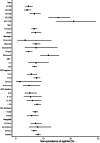Sero-prevalence of syphilis infection among people living with HIV in Sierra Leone: a cross-sectional nationwide hospital-based study
- PMID: 37932713
- PMCID: PMC10626761
- DOI: 10.1186/s12879-023-08740-9
Sero-prevalence of syphilis infection among people living with HIV in Sierra Leone: a cross-sectional nationwide hospital-based study
Abstract
Background: Globally, there were an estimated 7.1 million new syphilis infections in 2020, with more than 30% of these new infections reported in African countries such as Sierra Leone. Despite this, there is no HIV-specific syphilis screening program in Sierra Leone. Thus, data are needed to inform public health practice. In this study, we aimed to determine the prevalence of syphilis seropositivity and factors associated with syphilis seropositivity among people living with HIV (PLHIV).
Methods: A cross-sectional study was conducted at 10 health facilities in Sierra Leone, among adults with HIV, aged 18 years or older, from September 2022 to January 2023. Parameters of interest were collected including age, sex, marriage, antiretroviral therapy (ART) regimen, HIV viral load, duration of ART treatment, and hospital level of care. The syphilis antibody was detected by a rapid test based on immunochromatography assay. Data were analyzed using R-software version 4.2.3 (R Core Team, Vienna, Austria). Pearson's χ2 test, Fisher's exact test and Kruskal-Wallis H test were applied to assess the differences in syphilis seropositivity between groups as appropriate. Univariate logistic regression and multivariate logistic regression analysis was used to assess factors associated with syphilis seropositivity. The level of statistical significance was set at P < 0.05.
Results: Of the 3082 PLHIV individuals in our study, 2294 (74.4%) were female and 2867 (93.0%) were receiving ART. With a median age of 36 years, 211 (6.8%, 95% CI 6.0-7.7) were positive for syphilis. The prevalence of syphilis was highest in people aged 60 years and over (21.1%, 95%CI 14.7-29.2), followed by people aged 50-60 years (15.5%, 95%CI 11.9-19.9) and in the widowed population (11.9%, 95%CI 8.9-15.8). There were no differences in syphilis seropositivity between gender, ART status, ART regimen, duration of ART, HIV viral load and hospital level of care. Older age (50-60 years: adjusted OR 3.49, 95%CI 2.09-5.85 P < 0.001; 60-100 years: adjusted OR 4.28, 95%CI 2.21-8.17, P < 0.001) was an independent predictor of seropositive syphilis.
Conclusions: We observed a high prevalence of syphilis among PLHIV. Older people and widowed population have higher syphilis seropositivity. Older age was an independent predictor of syphilis positivity. Therefore, we call for the integration of syphilis screening, treatment and prevention in HIV services.
Keywords: Freetown; People living with HIV; Seropositivity; Sierra Leone; Syphilis; Syphilis screening.
© 2023. The Author(s).
Conflict of interest statement
The authors declare no competing interests.
Figures
Similar articles
-
Prevalence and viral suppression of hepatitis B virus infection among people living with HIV on antiretroviral therapy in Sierra Leone.Sex Transm Infect. 2024 Jul 26;100(5):264-270. doi: 10.1136/sextrans-2023-056042. Sex Transm Infect. 2024. PMID: 38789266
-
Prevalence and Risk Factors for Human Immunodeficiency Virus (HIV) and Syphilis Infections Among Military Personnel in Sierra Leone.Curr HIV Res. 2017;15(2):128-136. doi: 10.2174/1570162X15666170517101349. Curr HIV Res. 2017. PMID: 28521722
-
Hidden dangers-prevalence of blood borne pathogens, hepatitis B, C, HIV and syphilis, among blood donors in Sierra Leone in 2016: opportunities for improvement: a retrospective, cross-sectional study.Pan Afr Med J. 2018 May 18;30:44. doi: 10.11604/pamj.2018.30.44.14663. eCollection 2018. Pan Afr Med J. 2018. PMID: 30167071 Free PMC article.
-
Prevalence of viral hepatitis B and C in Sierra Leone-current knowledge and knowledge gaps: a narrative review.Trans R Soc Trop Med Hyg. 2021 Oct 1;115(10):1106-1113. doi: 10.1093/trstmh/trab054. Trans R Soc Trop Med Hyg. 2021. PMID: 33772308 Free PMC article. Review.
-
Prevalence of Chronic Hepatitis B Virus Infection in Sierra Leone, 1997-2022: A Systematic Review and Meta-Analysis.Am J Trop Med Hyg. 2023 May 22;109(1):105-114. doi: 10.4269/ajtmh.22-0711. Print 2023 Jul 5. Am J Trop Med Hyg. 2023. PMID: 37217165 Free PMC article.
Cited by
-
Sex-disaggregated analysis of age-standardized human immunodeficiency virus/acquired immune deficiency syndrome and sexually transmitted infections prevalence in Sierra Leone: insights from the World Health Organization health equity assessment toolkit data.BMC Public Health. 2025 Jul 29;25(1):2583. doi: 10.1186/s12889-025-23828-4. BMC Public Health. 2025. PMID: 40730997 Free PMC article.
-
Community and Hospital HIV Follow-Up Clinics Achieve Similar Lumbar Puncture and Syphilis Treatment Success in Patients with HIV-Syphilis Coinfection: Saskatoon, SK, Canada.J Assoc Med Microbiol Infect Dis Can. 2025 May 29;10(2):171-178. doi: 10.3138/jammi-2024-0038. eCollection 2025 Jun. J Assoc Med Microbiol Infect Dis Can. 2025. PMID: 40673055 Free PMC article.
-
Provincial distribution and factors associated with self-reported sexually transmitted infections and their symptoms among women in Sierra Leone.BMC Infect Dis. 2024 Nov 8;24(1):1265. doi: 10.1186/s12879-024-10030-x. BMC Infect Dis. 2024. PMID: 39516716 Free PMC article.
References
-
- Global progress report on HIV, viral hepatitis and other sexually transmitted infections. (2021). Available at: https://www.who.int/data/gho/data/themes/topics/data-on-syphilis. (Accessed 2 June 2023).
MeSH terms
Grants and funding
LinkOut - more resources
Full Text Sources
Medical
Miscellaneous



